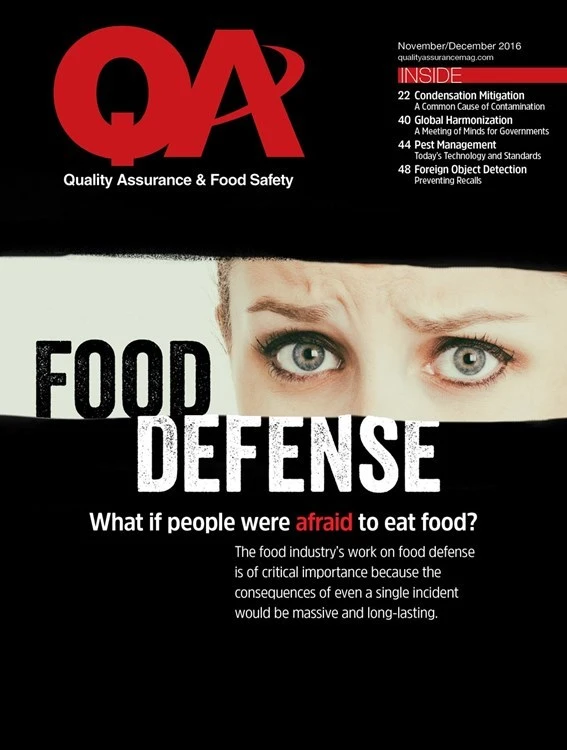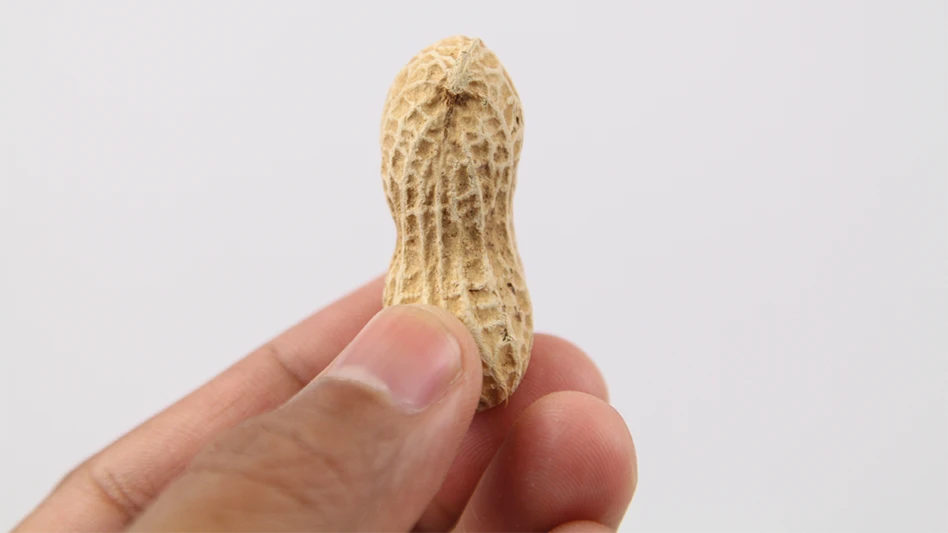
By Lisa Lupo
Condensation is common in many food manufacturing facilities, particularly those whose operations include both cool and warm processes. And if not mitigated and controlled, condensation can be a crucial cause of food adulteration.
Condensation is caused from relative humidity and air temperature differentials in an environment (psychrometrics), explained Penn State University Assistant Professor and Extension Meat Specialist Jonathan Campbell. “Just like, at times in the early morning, there is dew on the ground, condensation is related to the dew point and amount of water vapor in the air. If the air temperature and dew point temperature are the same, the air is fully saturated and can form condensation on surfaces (ceilings, walls, pipes, conduit, etc.).”
Then, once formed, Campbell said, the condensation can cause a water droplet to fall onto the food product. If contaminated, this water droplet could be a source of bacterial, chemical, or foreign material contamination for the food. For example, he said, “Bacterial cells (e.g. Listeria monocytogenes) that may be in the food production environment may get suspended on the water droplet formed from the condensation.” If the droplet falls from the surface, i.e., a ceiling, onto the product, and that moisture is contaminated, it could now contaminate the food.

It is likely of little surprise that the highest level of probability for contamination exists when there is condensation above a post-kill step line with open, ready-to-eat food, it may be more of a revelation that the sanitation process is often a major cause of condensation in the food facility. For example, said 3M Research Specialist Steve Swanson, when a protein-producing plant that has a cool, dry environment is shut down for sanitation, the first step generally involves the application of pressurized hot water, which adds high levels of moisture that then condenses on surfaces around the plant.
Additionally, Swanson said, standard plant processes can create condensation issues, such as that of a freezer tunnel. The space between the warm plant environment and the -20F freezer are ripe for the formation of condensation; and can result in moisture dropping onto open product that flows through the tunnel. “There is a big concern when it occurs on ready-to-eat food,” Swanson said. “So it is a high-risk area.”
CONDENSATION MITIGATION. Condensation is not an unknown in the industry, Swanson said, “Most people understand it. The question is how to mitigate it.” USDA and FDA regulations, including FSMA, have a number of references to condensation focused on avoidance and prevention, but not how to do this. Because of this, he said, “The industry is ripe for innovation, from our perspective, for tools that can make their environments drier.” Swanson sees there as being three main methods plants can employ to reduce condensation and mitigate contamination:
- HVAC. Exchanging and drying air as much as possible. But it can be expensive to increase air handling in a food plant.
- Manual intervention. Manually wiping condensation with long-handled mops and squeegees is a common practice. However, it requires manual labor and time investment and can potentially spread contamination onto adjacent surfaces. Manual intervention is often used to mitigate condensation formed from sanitation processes or large temperature differential zones, such as freezer tunnel entrances and exits. Some companies also employ “sentries” to monitor condensation during production and mop it down before it can a cause a problem.
- Condensation management film. A new innovation, the film is adhered to the underside of overhead surfaces, such as pipes, that tend to form condensation. The surface of the film has microscopic capillary channels, “so when condensation forms, water spreads across the surface and evaporates eight times faster,” Swanson said. The film only works in areas of intermittent high humidity; it cannot work in areas of continual condensation, such as a chronically cold pipe in a hot environment, because the surface temperature of the pipe is always below the atmospheric temperature and humidity dew point. “If it is always condensing, evaporation cannot occur,” he said.
These methods provide varying measures of mitigation, with wiping and mopping being the most common — if not the most effective, even as more innovative options become available. “The industry tends to be slow to change, risk-averse and highly regulated,” said 3M Business Development Manager Dave Peterson. While there are some early adapters, the more common question tends to be, “Who else is doing this?” As with many food safety cultural changes, it is a matter of education and getting facilities to ask themselves why they are doing things the way they are, then changing behavior to accept and implement new, more effective methods, he said.
While there are various means by which condensation can be controlled, it should be considered as a potential source of contamination to the food, and included in a facility’s food safety plan or HACCP plan, Campbell said. Whether you are a USDA-regulated plant implementing HACCP prerequisite program or a plant subject to FDA’s FSMA rules on preventive controls, all food facilities should outline the steps needed to control any potential condensation hazard, then document that the task was performed.
The author is Editor of QA magazine. She can be reached at llupo@gie.net.
Explore the December 2016 Issue
Check out more from this issue and find your next story to read.
Latest from Quality Assurance & Food Safety
- AFDO Webinar Series Offers Strategies for Difficult Times
- FDA, USDA Rehire Some Staff, Multiple Sources Report
- Nestlé Opens Arizona Beverage Factory and Distribution Center
- Ingredion Invests $100 Million in Indianapolis Plant to Improve Efficiency, Enable Texture Solutions Growth
- Eagle Unveils Redesigned Pipeline X-ray System
- USDA Invests Up To $1 Billion to Combat Avian Flu, Reduce Egg Prices
- Washington Cats Confirmed with HPAI as Investigation into Contaminated Pet Food Continues
- USDA Confirms Bird Flu Detected in Rats in Riverside





